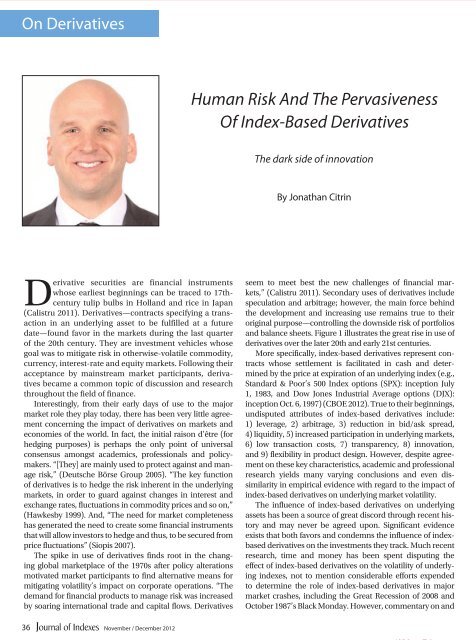Download complete issue - IndexUniverse.com
Download complete issue - IndexUniverse.com
Download complete issue - IndexUniverse.com
Create successful ePaper yourself
Turn your PDF publications into a flip-book with our unique Google optimized e-Paper software.
On Derivatives<br />
Human Risk And The Pervasiveness<br />
Of Index-Based Derivatives<br />
The dark side of innovation<br />
By Jonathan Citrin<br />
Derivative securities are financial instruments<br />
whose earliest beginnings can be traced to 17thcentury<br />
tulip bulbs in Holland and rice in Japan<br />
(Calistru 2011). Derivatives—contracts specifying a transaction<br />
in an underlying asset to be fulfilled at a future<br />
date—found favor in the markets during the last quarter<br />
of the 20th century. They are investment vehicles whose<br />
goal was to mitigate risk in otherwise-volatile <strong>com</strong>modity,<br />
currency, interest-rate and equity markets. Following their<br />
acceptance by mainstream market participants, derivatives<br />
became a <strong>com</strong>mon topic of discussion and research<br />
throughout the field of finance.<br />
Interestingly, from their early days of use to the major<br />
market role they play today, there has been very little agreement<br />
concerning the impact of derivatives on markets and<br />
economies of the world. In fact, the initial raison d’être (for<br />
hedging purposes) is perhaps the only point of universal<br />
consensus amongst academics, professionals and policymakers.<br />
“[They] are mainly used to protect against and manage<br />
risk,” (Deutsche Börse Group 2005). “The key function<br />
of derivatives is to hedge the risk inherent in the underlying<br />
markets, in order to guard against changes in interest and<br />
exchange rates, fluctuations in <strong>com</strong>modity prices and so on,”<br />
(Hawkesby 1999). And, “The need for market <strong><strong>com</strong>plete</strong>ness<br />
has generated the need to create some financial instruments<br />
that will allow investors to hedge and thus, to be secured from<br />
price fluctuations” (Siopis 2007).<br />
The spike in use of derivatives finds root in the changing<br />
global marketplace of the 1970s after policy alterations<br />
motivated market participants to find alternative means for<br />
mitigating volatility’s impact on corporate operations. “The<br />
demand for financial products to manage risk was increased<br />
by soaring international trade and capital flows. Derivatives<br />
seem to meet best the new challenges of financial markets,”<br />
(Calistru 2011). Secondary uses of derivatives include<br />
speculation and arbitrage; however, the main force behind<br />
the development and increasing use remains true to their<br />
original purpose—controlling the downside risk of portfolios<br />
and balance sheets. Figure 1 illustrates the great rise in use of<br />
derivatives over the later 20th and early 21st centuries.<br />
More specifically, index-based derivatives represent contracts<br />
whose settlement is facilitated in cash and determined<br />
by the price at expiration of an underlying index (e.g.,<br />
Standard & Poor’s 500 Index options (SPX): inception July<br />
1, 1983, and Dow Jones Industrial Average options (DJX):<br />
inception Oct. 6, 1997) (CBOE 2012). True to their beginnings,<br />
undisputed attributes of index-based derivatives include:<br />
1) leverage, 2) arbitrage, 3) reduction in bid/ask spread,<br />
4) liquidity, 5) increased participation in underlying markets,<br />
6) low transaction costs, 7) transparency, 8) innovation,<br />
and 9) flexibility in product design. However, despite agreement<br />
on these key characteristics, academic and professional<br />
research yields many varying conclusions and even dissimilarity<br />
in empirical evidence with regard to the impact of<br />
index-based derivatives on underlying market volatility.<br />
The influence of index-based derivatives on underlying<br />
assets has been a source of great discord through recent history<br />
and may never be agreed upon. Significant evidence<br />
exists that both favors and condemns the influence of indexbased<br />
derivatives on the investments they track. Much recent<br />
research, time and money has been spent disputing the<br />
effect of index-based derivatives on the volatility of underlying<br />
indexes, not to mention considerable efforts expended<br />
to determine the role of index-based derivatives in major<br />
market crashes, including the Great Recession of 2008 and<br />
October 1987’s Black Monday. However, <strong>com</strong>mentary on and<br />
36<br />
November / December 2012

















